Bournemouth Corporation Tramways
History
Bournemouth opened its new electric tramway system on the 23rd July 1902, which it eventually expanded to reach Poole — on the 16th June 1905 — through its operational takeover of the neighbouring British Electric Traction Company system, Poole and District Electric Tramways. The P&DET's tracks passed into the ownership of Poole Corporation, with Bournemouth Corporation working the lines under a lease agreement. The system remained in municipal ownership until 1935, when Poole Corporation sold its tracks (and operating rights) to Hants and Dorset Motor Services, the last tram service in Poole running on the 7th June 1935. Meanwhile, Bournemouth pressed ahead with its own programme to replace the trams with trolleybuses, which it duly completed on the 8th April 1936.
Bournemouth shares the dubious honour, with Metropolitan Electric Tramways Limited, of having to have its vehicles fitted with both overhead and conduit current collection equipment. Whilst the M.E.T were effectively forced to do this in order to run over London County Council Tramways metals, in Bournemouth's case this was self-imposed, as the corporation opted for conduit collection over the central section of the system, so as not to have the genteel vista spoiled by unsightly overhead wires. Conduit slots were, however, not only expensive, but also troublesome when used near the sea — they had a tendency to fill with sand and other wind-blown detritus —a fact that eventually led to their displacement in favour of overhead wiring in May 1911.
Uniforms
Apart from the caps, the general style of uniform appears to have remained unchanged for the entire life of the system (1902-1936). The tunics were single-breasted with five buttons (presumably brass — see link), two breast pockets (with button closures) and stand-up collars; the latter carried an employee number on the bearer's left-hand side (in individual metal numerals) and system initials ('B C T', in individual metal letters) on the right-hand side. Photographs occasionally show staff wearing a cloth chevron on the left arm of their tunics; this was almost certainly to recognise long service or good conduct.
The caps were initially of the drooping-peak type; they bore metal script-lettering grade badges, either 'Conductor' or 'Motorman', along with a small municipal-device badge (worn above the grade badge). Between 1908 and 1910, the drooping-peak caps were superseded by tensioned-crown peaked caps, the crown (top) being appreciably wider than the main body of the cap; the cap insignia, however, remained unchanged. The badges and buttons were in all probability brass for the entire life of the system, though there remains a possibility that nickel may have made an appearance in later years.
Tramcar crews were also provided with long, double-breasted greatcoats bearing five pairs of buttons, epaulettes and high, fold-over collars; these do not appear to have carried insignia of any kind.
Although photographic evidence of inspectors is exceedingly sparse, a single early photograph does suggest that the first uniforms were very similar to those issued to tramcar crews, namely, single-breasted tunics with stand-up collars, and drooping-peak caps; the latter appear to have borne the standard municipal-device cap badge, along with another long badge, very possibly the grade — 'INSPECTOR' — probably in embroidered lettering. Smart double-breasted greatcoats (with plain buttons and lapels) were also worn; these garments bore a badge on both collars, once again very likely the bearer's grade (in embroidered lettering). At some point, and certainly by 1914, inspectors' uniforms had changed to a more typical style for the grade, namely single-breasted jackets with hidden buttons (or more likely a hook and eye affair), edged in a finer material than the main body, with two waist-level slit pockets and stand-up collars; the latter bore a broadly oval badge, possibly embroidered. By this time, the peaked caps were of the tensioned-crown type; they bore a long badge on a hat band, again probably embroidered, and possibly bearing the grade.
Unlike the vast majority of tramway systems, which employed women during the Great War to replace male employees lost to the armed services, Bournemouth elected not to employ female staff; instead, the corporation adopted a policy of employing boys aged 16 to 18 years, who were ostensibly ineligible for call up due to their age.
Further reading
For a history of the system, see: 'Bournemouth and Poole Tramways' by R Anderson; Middleton Press (1995).
Images
Motormen and conductors
A studio portrait of a Bournemouth Corporation Tramways conductor — photo undated, but probably taken in 1902/3. The photographer was R J Scott of 292 Holdenhurst Rd E. Bournemouth. Author's Collection.
An enlargement of the above photograph showing the collar insignia and the municipal-device cap badge, topped by a pine tree. The subject is probably Employee No 126.
Bournemouth municipal-device cap badge — brass. Author's Collection.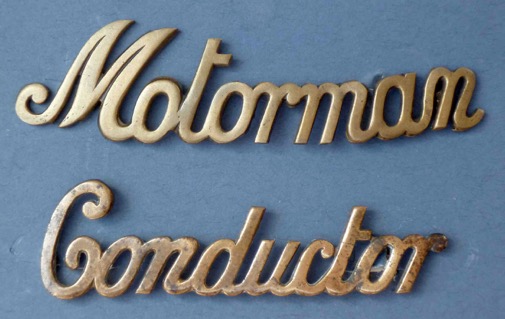
Standard off the shelf script-lettering grade badges of the type used by Bournemouth Corporation on tramcar crew caps — brass. Author's Collection.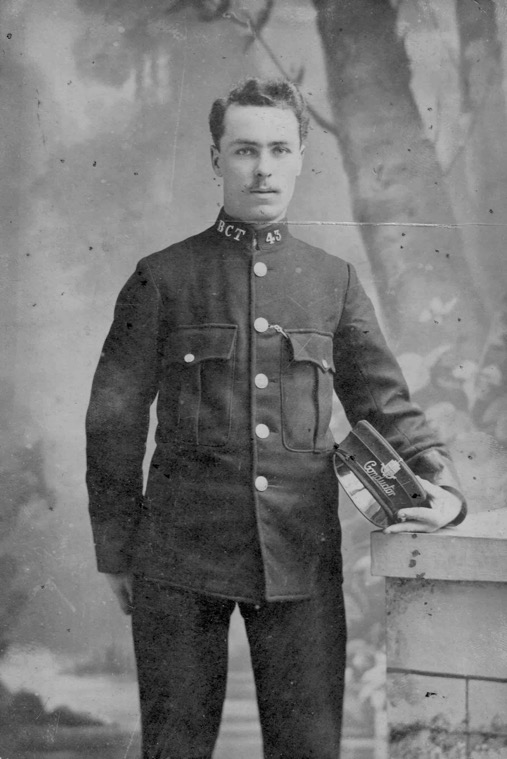
Another studio portrait of a Bournemouth Corporation Tramways conductor, this time Employee No 43 — photo undated, but probably taken around the time of opening, i.e., 1902. The photographer was J A Ranger of Richmond Park Studio, Bournemouth.
An enlargement of the above photograph showing details of the insignia on the subject's drooping-peak cap.
The crew of Tramcar No 6, bound for Boscombe, pose for the cameraman at the Landsdowne Road conduit change pit — photo undated, but very probably taken shortly after the opening in 1902. Photo courtesy of the National Tramway Museum.
An enlargement of the above photograph showing the conductor, in his single-breasted tunic and drooping-peak cap.
The crew of Tramcar No 50 pose for the cameraman with a service to County Gates — photograph undated, but almost certainly taken before July 1905 when the tracks of the Bournemouth and Poole tramway systems were connected (at County Gates), and through services were introduced. Photo courtesy of the Tramways and Light Railway Society, with thanks to David Voice.
An enlargement of the above photograph showing the conductor (in a single-breasted tunic), and the motorman (in a double-breasted greatcoat). 
A conductor and a motorman pose with Tramcar No 17 in the middle of what is probably High Street (terminal stub) in Christchurch — photo undated, but probably taken in 1908. Source unknown.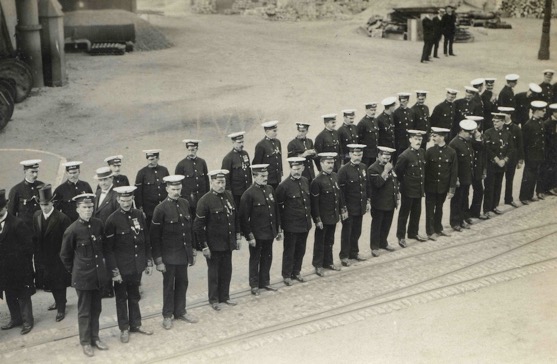
A line-up of Bournemouth Corporation Tramways staff, predominantly motormen, possibly outside Southcote Depot — photo undated, but almost certainly late Edwardian given the high proportion of moustaches. Only the older men are wearing medals, suggesting that they were veterans of the Boer War. With thanks to Stephen Howarth.
An enlargement of the above photograph showing several motormen. By this time the drooping-peak caps had been superseded by tensioned-crown peaked caps. The chevrons on the upper arm of the jackets probably denote either long service, good conduct, or seniority.
Although a poor-quality image, this photo of Tramcar No 79 at Tuckton Bridge is believed to have been taken in 1910, indicating that the drooping-peak caps had been superseded by tensioned-crown peaked caps by this date. Author's Collection.
Bournemouth Corporation Tramways conductor (Employee No 103) — photo undated, but possibly taken shortly before the Great War. The photographer was J Deayton of Winton, Bournemouth. Author's Collection.
An enlargement of the above photograph showing details of the uniform. The photograph is so sharp, that the system can be identified from the button alone.
Tramcar No 54 stands at the terminus next to Poole Station. Although the photo is undated, posters on the left advertise 'Marie Tempest in The Marriage of Kitty' at the Theatre Royal in Bournemouth, a play which was revived around 1911, so the date is probably between then and the outbreak of the Great War. Photo courtesy of the National Tramway Museum.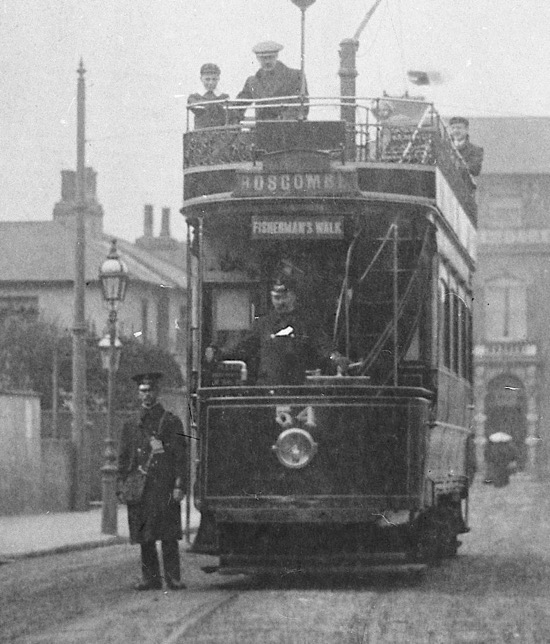
An enlargement of the above photograph showing the crew, both men wearing greatcoats and tensioned-crown peaked caps.
A studio portrait of two Bournemouth conductors (Employees No 95 and No 2) — photo undated, but given that both men are clean-shaven and wearing tensioned-crown peaked caps, probably taken shortly before or shortly after the Great War. The collar insignia are clearly discernible, as is the quality of the uniform. Author's Collection.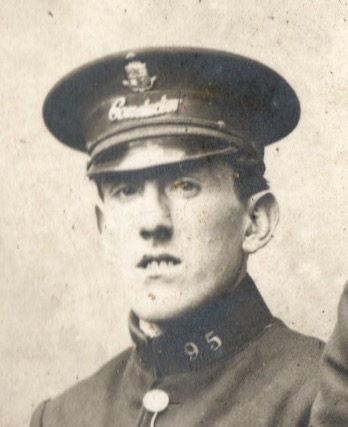
An enlargement of the above photograph, clearly showing the pine tree atop the municipal-device badge.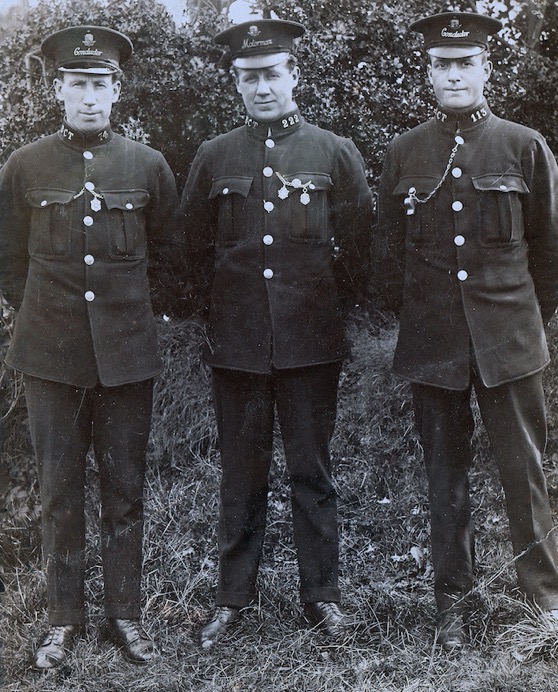
Two conductors and a motorman (Employees No 74, 222 and 113) — photo undated, but probably taken in the late 1920s or early 1930s. Photo courtesy of Grant Kemp.
Tramcar and maintenance staff pose with Tramcar No 28 — photo undated, but probably taken in the late 1920s or early 1930s. Photo courtesy of the Tramways and Light Railway Society, with thanks to David Voice.
A motorman and a conductor pose aboard Tramcar No 46 in the depot — photo undated, but possibly taken on the same day as the preceding shot. Photo courtesy of the Tramways and Light Railway Society, with thanks to David Voice.
Possible 'tramways era' cap badge — nickel plated brass (curiously, there is no sign of this badge ever having had the tree seen on the previous badge and photos). Author's Collection.
Senior staff
A pristine-looking Tramcar No 35 with an inspector (left), a conductor and a motorman — photo taken on the 12th May 1904. Source unknown.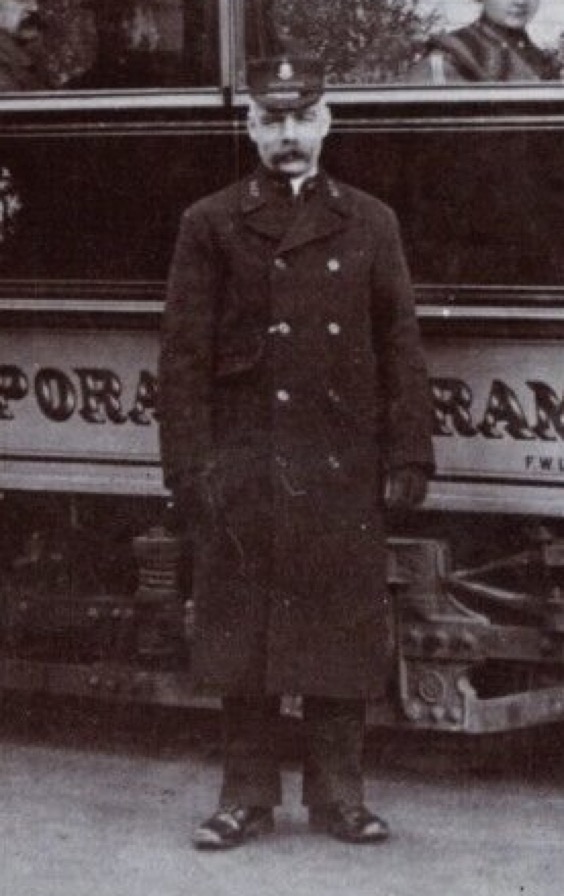
An enlargement of the above photograph showing the inspector. He is wearing a double-breasted greatcoat with embroidered lettering on both collars — probably his grade — along with a drooping-peak cap bearing the standard municipal-device cap badge, and what is probably an embroidered grade badge. The stand-up collars of his tunic can just be seen beneath the greatcoat.